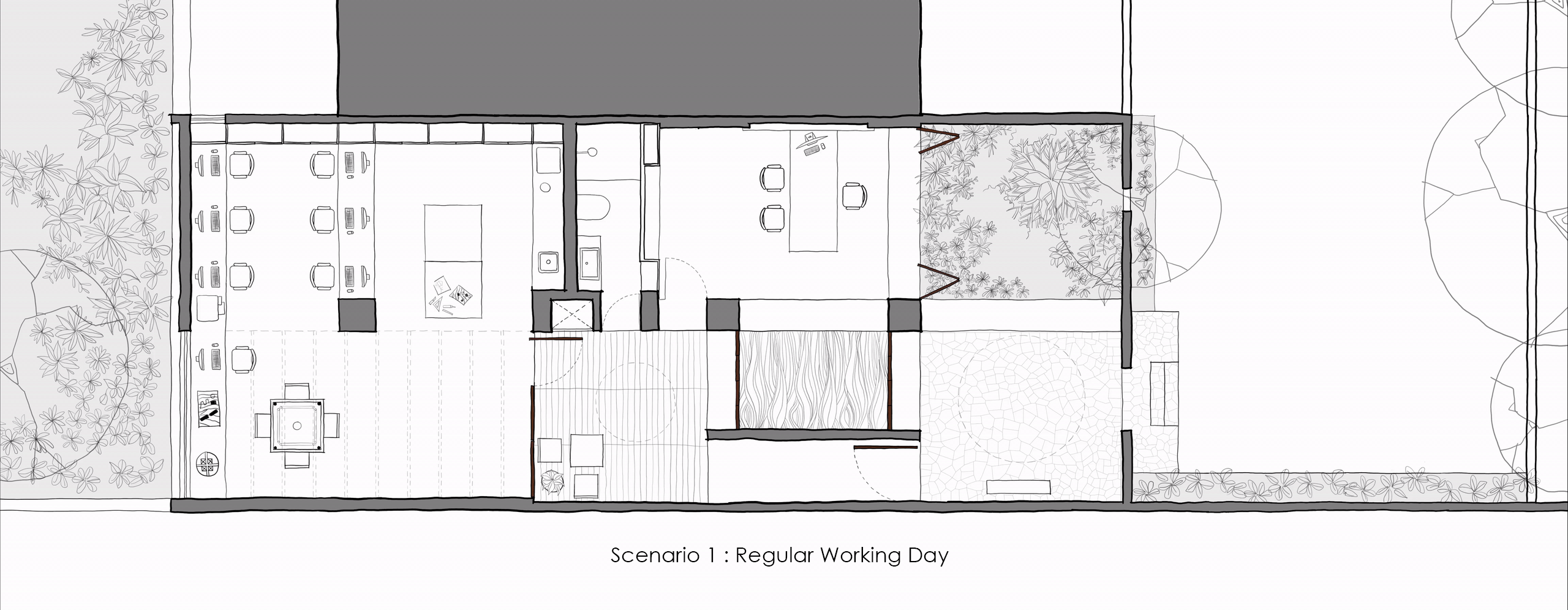这个项目的主要意图是加强和夸大场地的 “现成 “空间条件,尽量减少空间姿态的衔接,以容纳一个建筑实践。
The main intention of this project was to enhance and exaggerate the ‘as found’ spatial condition of the site with as little articulation of spatial gestures as necessary to house an architectural practice.
给定的场地位于纳西克郊区的一栋公寓楼的棚屋内,北侧紧邻一个巨大的森林保护区。这就要求沿着森林保护区的长度,建筑的院墙要高一些,至少有8到9英尺高。场地位于一侧的半覆盖棚和另一侧的高墙之间,这种设置立即赋予了场地一种矛盾的特性,它被某种质量的光和影所激励着。某种空洞的空间被来自天空的光线冲刷,创造出一种阴郁而又欢快的气氛。一旦这种空间质量被识别和发现,项目的意图是通过仔细和最小的空间衔接来加强这种空间质量。
The given site was located in the stilt space of an apartment building, in the suburbs of Nasik, abutting a vast forest reserve along the Northern side. This necessitated that the compound wall of the building, along the length of the forest reserve, be taller, at least 8 to 9 feet in height. This setting of the site situated between a semi covered stilt on one side and a tall wall on the other side immediately gave the site an ambivalent character that was animated by a certain quality of light and shadow. A certain kind of cavernous space which is washed by light from the sky to create a somber, yet cheerful, atmosphere. Once this spatial quality was identified and discovered, the intention of the project was to enhance this spatial quality through careful and minimal spatial articulation.
这方面的第一个决定是用一种单一的材料渲染整个空间,即I.P.S(印度专利石)。为了创造一种同质化的空间感,我们对空间的现有元素进行了细微的修正。例如,现有的柱子大小不一,朝向不同的方向,被纠正为所有的方柱。这在空间中创造了一种重量感、节奏感和秩序感,类似于纳西克周围发现的岩石切割的洞穴寺庙。为此,我们选择了深灰色的IPS色调和纹理,与岩洞寺庙的玄武岩表面的黑色非常相似。
The first decision with this regard was to render the entire space in one single material, that of the I.P.S (Indian Patented Stone). In order to create a sense of homogeneous space minor corrections were made to the existing elements of the space. For example, the existing columns, which were uneven in sizes and oriented in different directions, were corrected by making all of them as square columns. This creates a sense of weightiness, rhythm and order in space akin to the rock-cut cave temples found around Nasik. To that extent, a dark-grey tone and texture of IPS was chosen which closely resembled the blackness of basalt surfaces of the rock-cut cave temples.

使用IPS的专业工匠团队来自西孟加拉邦。IPS地板和墙面的技术曾经是印度一些地区的常见技术,今天已经成为一种专业的工艺,只有少数工匠掌握。为了达到一种特殊的表面光洁度、质地和光泽,不仅需要仔细和直观的感觉,还需要专门的技术来固化和抛光表面–在墙壁和天花板上应用I.P.S总是特别具有挑战性,因为它更多地是用于地板。
The team of expert craftsmen that worked with IPS came from West Bengal. The technique of IPS flooring and walling was once a common technique in several parts of India, which today has become a specialised process, mastered by few craftsmen. To achieve a particular kind of surface finish, texture and sheen it takes careful and intuitive sense of not only applying the material but also specialised techniques of curing and polishing the surfaces -it is always particularly challenging to undertake the application of I.P.S on walls and ceilings, as it is more often than not used for flooring.
第二个决定是在场地内设置不同的日光条件的戏剧。1)入口处的开放庭院;2)场地尽头的工作室空间;3)入口和工作室之间的通道和非正式的等待空间;4)会议空间;5)水庭。从这个意义上说,这里的光线被视为下一个重要的材料,通过一天和四季的变化,在空间内创造出一种戏剧感。
The second decision was to frame the drama of varying daylight conditions in the site: 1) Open court at the entrance; 2) studio space at the end of the site; 3) passage and informal waiting space between the entrance and the studio; 4) meeting space; 5) water court. In that sense, light here is treated as the next important material that creates a sense of drama inside the space through the day and through changing seasons.
入口处有一个巨大的环形天窗,既是为了框住天空,也是为了创造一个半遮蔽的聚会空间。除了座位空间,还有一个植被茂密的景观庭院,它也向天空开放。从质量上讲,入口处的设计考虑到了印度几个城市中的典型中世纪内城定居点的房屋入口处。 一条狭窄的、天花板高度较低的通道从入口庭院通向工作室空间,并以一条狭窄的天窗缝为标志,这也增加了空间的线性,同时使其感觉更宽敞。
The entrance court has a vast circular skylight, both to frame the sky but also to create a semi shaded gathering space. Besides the seating space is a landscaped court with dense vegetation which is also left open to the sky. Qualitatively speaking, the entrance court is designed keeping in mind the entrance court of houses typical to medieval, inner city settlements found across several Indian cities. A narrow passage with low ceiling height leads from the entrance court to the studio space and is marked by a narrow slit of skylight, which also adds to the linearity of the space, while making it feel more spacious.
在通道和工作室空间之间,有一个小型的非正式等待空间,它再次被一个较小的圆形天窗所点缀。工作室空间充分利用了环境的优势,在建筑边缘和高大的复合墙之间留出了整个后退的天窗。会议空间通向天窗水庭,水庭上有凉棚,另一边是景观庭院,构成会议空间的背景。水庭也向等待空间和入口庭院开放,使其成为设计的关键空间,几乎可以从项目的任何部分体验到。
Between the passage and the studio space there is a small informal waiting space which is once again punctuated by a smaller circular skylight. The studio space takes the full advantage of the setting by leaving the entire set-back skylit, between the building edge and the tall compound wall. The meeting space opens to a skylit water court, with pergolas over it and with the landscaped court on the other side, which forms the backdrop for the meeting space. The water court also opens towards the waiting space and the entrance court, making it a pivotal space of the design which is experienced from almost any part of the project.
这两个意图,即庆祝给定的空间条件和光与影的戏剧性,也与工作室的组织和文化意图相吻合。建立一个具有横向和协作性工作结构的建筑事务所一直是我们的意图。工作室也被想象成一个为城市提供各种活动的空间。在这种程度上,第三个空间干预措施是拥有一个开放和灵活的平面图,以及一个同样开放的部分,这将使工作室的空间能够膨胀和收缩,以适应各种活动的需要。每个空间都有一套滑动折叠的围合装置,有时是门的形式,有时是窗的形式,这使得整个工作室的空间,从入口到工作室的尽头,都可以灵活开放,进行重新配置。
These two intentions, to celebrate the given spatial condition and the drama of light and shadow, also coincided with the organizational and cultural intention of the studio. It was always an intention to establish an architectural office that has a horizontal and collaborative structure of work. The studio was also imagined as a space for various kinds of events for the city . To this extent, the third spatial intervention was to have an open and flexible floor plan, and an equally open section, that would allow the studio space to swell and contract to adapt to various kinds of events. Each space has a set of sliding-folding enclosing devices that sometimes take the form of doors and sometimes windows, which enable the entire studio space, from the entrance to the end of the studio, to be flexible and open for reconfiguration.
该项目中的所有家具都是用回收的印度柚木制作的,这些柚木是从属于该城市和该地区商业时代的和田住房类型中打捞出来的。家具的细节是在仔细了解柚木纹理的方向性及其触觉质量的情况下制定的。会议空间中的可调节百叶窗也能与天气和气候条件有更细微的接触。柚木的质地和触觉质量与灰色的I.P.S空间形成了温暖的对比。
All furniture in the project is made in up-cycled Indian teak wood salvaged from the wada housing type belonging to the mercantile era of the city and the region. The furniture details are worked out with a careful understanding of the directionality of the grain of the teak wood and its tactile quality. The adjustable louvered windows in the meeting space also afford to have a more nuanced engagement with the weather and climatic conditions. The texture and tactile quality of the teak creates warm contrast to the grey I.P.S space.
唯一使用的其他材料是黑色玄武岩,用于入口庭院和台阶的地板,为空间的质量增加了另一层触感。
The only other material that is used is black Basalt for the flooring of the entrance court and steps which adds another layer of tactility to the quality of space.
Architects: A for Architecture
Area: 120 m²
Year: 2017
Photographs: Hemant Patil
Lead Architects: Ajay Sonar, Monali Patil
Design Team:Ajay Sonar, Monali Patil, Yogendra Nikam
Clients:a for architecture
Landscape Architects:Monali Patil, a for architecture
Text:Shreyank Khemalapure
Architects:A for Architecture
City:Nashik
Country:India

























